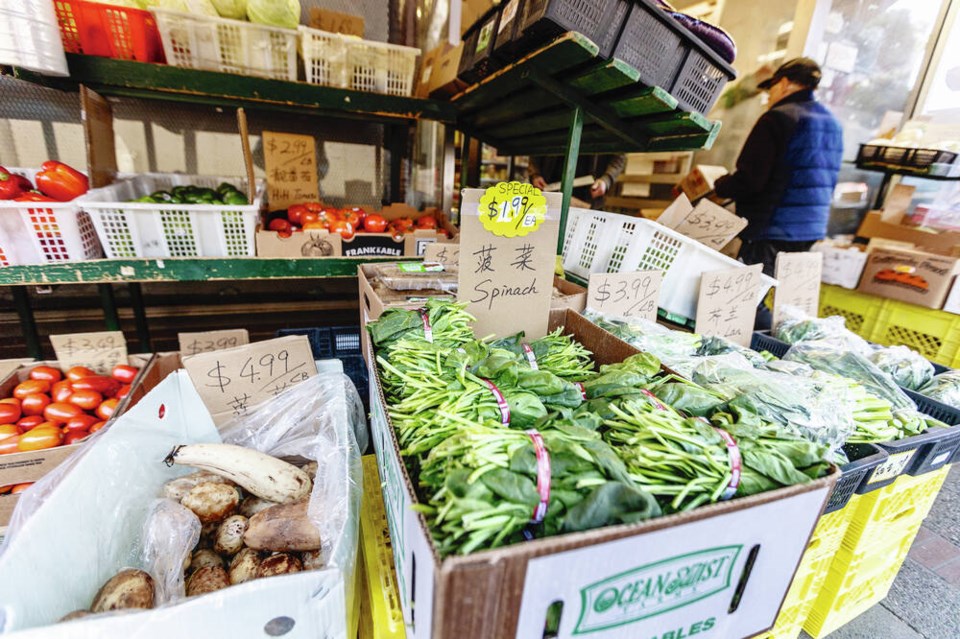Kim Metzger sees it every day.
Young adults, families with children and seniors are all coming into the Sooke Food Bank, unable to make ends meet.
They’re pressed into a difficult choice between paying their rent or buying food — the cost of both of which has gone through the roof over the past year.
One senior, down to her last $40 for the month, had to put gas in the car for a doctor’s appointment, leaving her no money to buy food, said Metzger, the food bank’s manager, noting use of the food bank is up by 30% this year.
So they come, proud but in desperate need for help with rent or a food hamper, which Thursday included cereals, vegetables and fruit and meat, says Metzger. “They’re just making it, but they really don’t know for how long,” she said Thursday.
Tough times are echoing throughout the region as food prices and other expenses rocket higher.
It’s making Greater Victoria one of the most expensive cities in the province to raise a family, according to the latest calculation of living wages in British Columbia.
The annual report by the non-profit Living Wage for Families B.C. and the Community Social Planning Council said inflation is making life even more difficult for the “working poor.”
The region’s hourly living wage has been calculated by social agencies at $24.29 per hour — up 20% from a year ago, the highest increase since the living wage was first calculated in 2008.
It’s also the first time Victoria’s rate is higher than Metro Vancouver’s, because of rising food costs and the extra expense of getting it here.
The living wage is defined as the hourly wage two working parents with two young children, ages four and seven, must each earn to meet their basic expenses, including rent, child care, food and transportation, after government taxes, credits, deductions and benefits have been taken into account.
The highest hourly living wages in the province are in Daajing, formerly Queen Charlotte City, ($25.87) and Golden ($25.56), communities also facing rapidly rising food and transportation costs because of remote locations.
The family living wage for Greater Victoria is calculated annually by the Community Social Planning Council of Greater Victoria as part of the Happiness and Wellbeing Community Lab, a collaboration with United Way Southern Vancouver Island.
In Greater Victoria, annual household expenses for a family of four rose by $10,229, a 12.65% increase from last year. That’s far above inflation and wages aren’t keeping up, according to the report.
With the exception of childcare — where costs decreased slightly, by 0.16% — costs are up across the board.
Housing and transportation continue to make up a substantial portion of annual expenses, while the cost of food and other household items has spiked — up 25.7% and 22%, respectively. Household items range from toiletries and bank fees to children’s activities and school supplies.
Those cost increases can be attributed to the high inflation rate, which peaked in May at 8.1%. According to the B.C. Consumer Price Index report, the cost of groceries is up 10.5% since 2021.
“With many of the region’s businesses reporting labour shortages, and food banks reporting increased numbers [of users], the living wage is a critical number this year,” Diana Gibson, executive director of the Community Social Planning Council, said Thursday.
“It is clear that both businesses and workers in the region are feeling the squeeze as they try to recover from the pandemic and both are looking to the province for more action on cost drivers.”
Danella Parks, director of community investment at United Way South Vancouver Island, said the pandemic has been especially hard on low-income families. “The high cost of living is making that even more challenging — with many reporting that they’re living paycheque to paycheque and often sacrificing basic needs to pay for rent and utilities.”
Median monthly rent for a three-bedroom apartment or townhouse is up $278 from a year ago to $2,123, making housing the greatest household expense in the region.
The Community Social Planning Council said many families — including nearly half of renter households in the Greater Victoria region — continue to live in “core housing need,” paying a higher proportion of their income for rent and utilities than is considered by Canada Mortgage and Housing Corp. to be affordable.
Living-wage reports for several locations in B.C. were released as part of VanCity’s provincial Living Wage for Families Campaign. Organizer Anastasia French said although Victoria faces some of the highest costs, they have risen everywhere in B.C.
The living wage dropped between 2018 and 2019 because of the province’s affordable-childcare benefit, although it began rising again last year. That drop, however, showed that “good government policy” can help reduce poverty, said Chelsea Power, research co-ordinator with the Community Social Planning Council.
None of the cities in the report came close to British Columbia’s minimum wage, which is set at $15.65 per hour on June 1.
More than 30 employers in Greater Victoria have been certified as living-wage employers, including Spinnakers Brew Pub, the District of Central Saanich, the City of Victoria, Pacifica Housing, Urban Solar and Community Plus, which provides home care.
Calen McNeil, owner of Big Wheel Burger, said the chain has been working toward being a living wage employer and has already exceeded that wage with tips. “We were getting close to that target wage, but [the latest increase] moves the finish line a lot farther away for us and any employer in a similar position.”
Back at the Sooke Food Bank, Metzger said people who have never experienced being poor “are feeling it now.”
“We’re seeing people who have never had a want for anything now in that situation … it’s changed quickly,” she said. “It hurts and it’s going to get worse.
“Wait until February or March when the hydro bills come in.”



